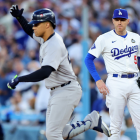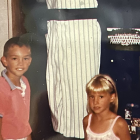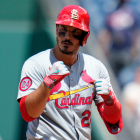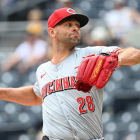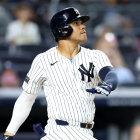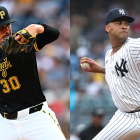The 2017 MLB season is now six weeks old, and while most teams still have 120-something games to play, the season is not that young anymore. Batting averages are starting to look normal -- there isn't a single player with enough plate appearances to qualify for the batting title hitting over .400 anymore -- and most of the spring training surprises have fizzled out. Baseball is getting back to normal.
At this point of the season we can begin to wonder whether a player's performance, either good or bad, is the result of tangible change and not simple randomness. Weird things happen in small sample sizes. We now have enough of the sample to see whether some trends exist. Four pitchers with a history of ace-caliber performance stand out for their early season struggles. Is it time for their teams to worry? Let's dive in.
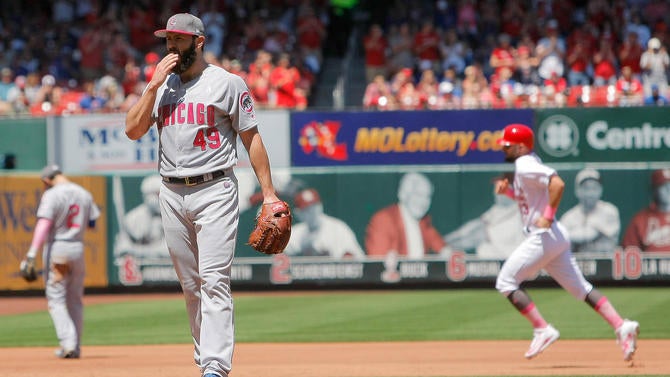
Two years ago Cubs righty Jake Arrieta won the NL Cy Young thanks to a historically great second half, and while he didn't repeat that performance in 2016, he was still very good. The 31-year-old threw 197 1/3 innings with a 3.10 ERA and a 1.08 WHIP in 2016. The biggest difference between 2015 Arrieta and 2016 Arrieta was walks. He went from 1.9 BB/9 to 3.5 BB/9.
Arrieta allowed four runs in six innings against the Cardinals on Sunday, giving him a 5.44 ERA and a 1.45 WHIP in 44 2/3 innings this season. His walk rate (2.6 BB/9) has been fine. Regular old hits have been the problem. Arrieta's hit rate has climbed from 5.9 H/9 in 2015 to 6.3 H/9 in 2016 to 10.5 H/9 in 2017. Not coincidentally, hitters are making better contact against him.
Line Drive % | Ground Ball % | Fly Ball % | Soft Contact % | Hard Contact % | |
2015 | 21.0 | 56.2 | 22.8 | 22.8 | 22.1 |
2016 | 19.5 | 52.6 | 27.9 | 22.9 | 25.2 |
2017 | 22.0 | 40.2 | 37.9 | 23.5 | 31.8 |
From 2015-16, Arrieta was the master at limiting hard contact -- the league average hard contact rate hovers around 31 percent each year -- and keeping the ball on the ground. This year hitters are making more hard contact and getting the ball in the air. Hard-hit fly balls tend to not only go for hits, but extra-base hits.
Why are hitters making harder contact and getting the ball airborne against Arrieta this year? Sometimes it's as simple as velocity. Arrieta's velocity is down nearly 2 mph across the board from last season. From Brooks Baseball:
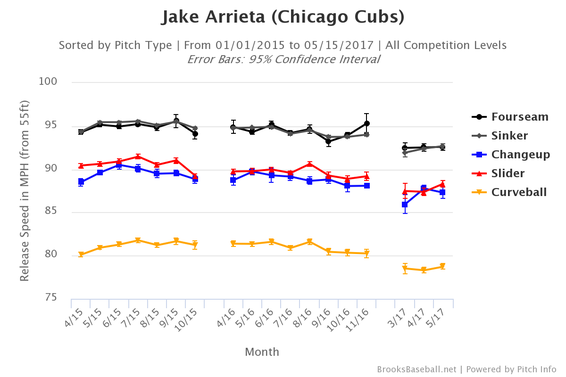
That is ominous. Arrieta endured a huge workload last season (219 2/3 innings, including postseason) and the year before (248 2/3 innings), and he may be feeling the effects now. Keep in mind command has never been Arrieta's strong suit, even during his Cy Young year, and when you combine less than stellar command with a loss of velocity, it can lead to things like, well, more hard hit balls in the air.
It's time to worry. True. Arrieta has thrown only 44 2/3 innings in 2017, but there are enough troubling early season trends. His velocity is way down, his ground ball rate is way down, and his hard contact allowed rate is way up. That's a bad combination.
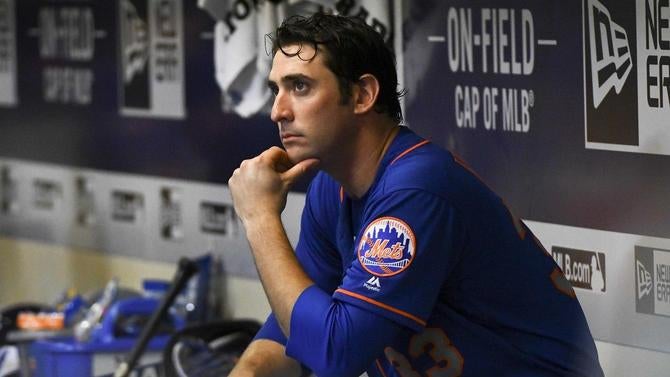
Erstwhile Mets ace Matt Harvey has been in the news for all the wrong reasons these last few weeks. The team suspended him three games for violating team rules, and later it got out Harvey failed to report for a game following a late night out on the town and morning round of golf. The Mets have reportedly been trying to rein in his off-the-field activities for a while now.
Friday night, in his most recent start, the Brewers blasted Harvey for five runs on seven hits (including three homers) and five walks in five innings. He struck out six. Harvey now has a 5.63 ERA and a 1.43 WHIP in 40 innings in 2017. Also, his strikeout rate (5.9 K/9) is too low and his walk rate (4.1 BB/9) is too high. This is a pitcher who came into the season with a career 9.1 K/9, remember.
Of course, Harvey did not pitch well last season either, throwing 92 2/3 innings with a 4.86 ERA. His last true ace-like season was 2015, when he posted a 2.71 ERA in 189 1/3 innings and helped the Mets get to the World Series. Harvey's 2016 season came to an abrupt end in July, when he needed surgery to treat thoracic outlet syndrome, a serious nerve issue that could potential end careers if not caught early enough.
Harvey's fastball is averaging 94.2 mph this year, down from 95.4 mph during his peak in 2013, though losing roughly 1 mph over the span of four seasons isn't unusual. The velocity is there. The problem is hitters aren't chasing out of the zone, and when Harvey does challenge hitters in the zone, they aren't missing. From FanGraphs:
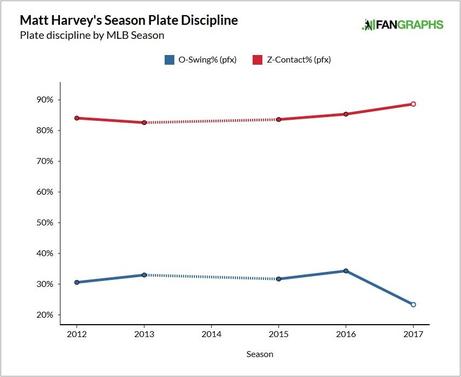
Harvey's chase rate (O-Swing%) is down to 23.3 percent this season, well below the 29.8 percent MLB average and his 33.4 percent career rate. That 9.1 K/9 coming into the season was built not only on Harvey overpowering hitters with high octane fastballs. He was also adept at getting them to chase pitches out of the zone for swings and misses. The chases aren't there right now.
Furthermore, the contact rate on Harvey's pitches in the strike zone (Z-Contact%) is up to 88.6 percent. The league average is 85.7 percent. His career average is 84.0 percent. So not only is Harvey currently unable to get hitters to chase out of the zone, he's also not missing as many bats when he does pitch in the strike zone. Baseball's best pitchers tend to be those who can generate swings and misses in the strike zone. Harvey can't do that right now.
It's time to worry. True, sort of. I'm inclined to cut Harvey some slack because he is coming off a very serious injury and surgery. There is no excuse for the off-the-field nonsense. Don't get me wrong. But I think the root cause of Harvey's present issues are tied more to the thoracic outlet syndrome surgery than a few late nights. The combination of Tommy John surgery, which Harvey had late in 2013, and thoracic outlet syndrome surgery is usually very bad news. Not many pitchers come all the way back from both. For now, consider me slightly worried, but willing to give Harvey more time to right to ship following surgery.
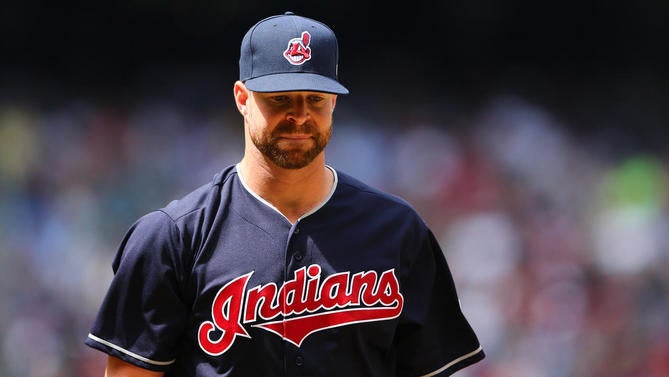
Unlike the other pitchers in this post, Indians ace Corey Kluber is currently on the disabled list. He is out with a lower back strain. The latest update says Kluber resumed throwing on flat ground over the weekend. The team hopes to have him back in their rotation by the end of the month. Obviously though they will not push it. Expect the Indians to be careful.
Before landing on the disabled list, Kluber made six starts and threw 37 1/3 innings with a 5.06 ERA and a 1.37 WHIP. He's also been uncharacteristically home run prone, allowing seven in those 37 1/3 innings for a 1.7 HR/9. That said, most of the home run damage came on Opening Day, when Kluber allowed three homers in six innings against the Rangers. He's allowed four homers in 31 1/3 innings since.
In the early going all of Kluber's core underlying stats are within range of his career norms. I'm talking about his strikeout (9.9 K/9) and walk (3.1 BB/9) rates, his ground ball (39.4 percent) an fly ball (37.5 percent) rates, and his sinker (92.1 mph) and slider (88.7 mph) average velocities. The home run rate is sky high and that's a problem. Everything else has been business as usual for Kluber. It could all be typical early season sample size noise.
It is important to note Kluber is coming off a massive workload last season. He threw 249 1/3 innings in 2016 between the regular season and postseason, and he made three postseason starts (including his final two) on short rest. That's a lot of intense innings. A lot of intense innings and a shorter offseason to recover. It's very possible Kluber is experiencing a bit of a World Series hangover right now.
It's time to worry. False. It will be if his back injury lingers, but not yet. Outside the home run rate -- a core peripheral stat, obviously -- Kluber's underlying performance is right in line with his career norms. With a little more help from the bullpen -- Cleveland's relievers have allowed every runner they've inherited from Kluber to score this season -- and a healthy back, Kluber should be fine going forward.
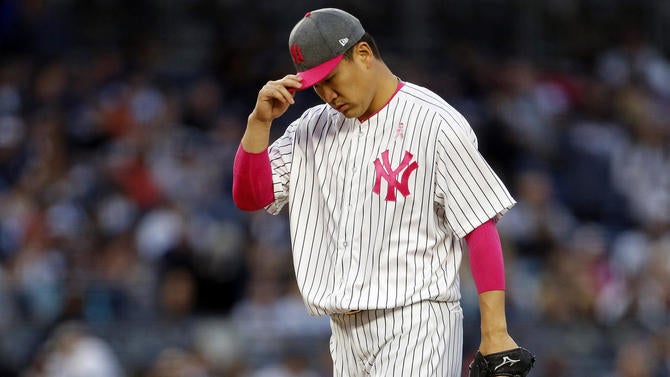
The Astros spoiled Derek Jeter's night at Yankee Stadium on Sunday by teeing off against Masahiro Tanaka. Houston hammered three first inning home runs, including an Alex Bregman grand slam, to take a 6-0 lead. Tanaka finished the night having allowed a career-high eight runs (including four homers) in a career-low 1 2/3 innings. He now has a 5.80 ERA and a 1.44 WHIP in 45 innings.
Last season Tanaka contended for the AL ERA crown most of the season, and he finished with a 3.07 ERA and 1.08 WHIP in 199 2/3 innings. It was his finest season since coming over from Japan and it earned him a seventh place finish in the AL Cy Young voting. And now, aside from a complete game shutout against the Red Sox three weeks ago, Tanaka has been mostly mediocre and occasionally terrible, like Sunday.
Unlike the other pitchers in this post, who achieved their ace-caliber success by overpowering hitters, Tanaka has been more of an artist on the mound. When right, he commands a deep arsenal of pitches and keeps hitters off-balance -- his trademark splitter is a big part of that -- as well as any pitcher in the game. And, weirdly enough, Tanaka's batted ball tendencies are nearly identical to last season.
Line Drive % | Ground Ball % | Fly Ball % | Soft Contact % | Hard Contact % | |
2016 | 20.7 | 48.2 | 31.0 | 18.5 | 32.4 |
2017 | 17.0 | 51.0 | 32.0 | 18.2 | 31.1 |
Tanaka's average sinker and splitter velocity in 2016: 90.4 mph and 86.6 mph. Tanaka's average sinker and splitter velocity in 2017: 90.9 mph and 87.4 mph. The velocity is there. Last season Tanaka ranked second among all pitchers with a 37.4 percent chase rate. He's a master at getting hitters to expand and go fishing for stuff off the plate. And so far this season Tanaka ranks sixth with a 35.8 percent chase rate. He's still got that working too. Hmmm.
The underlying numbers tell you everything should be okay, and yet, it's not. Tanaka has not pitched well overall this season despite a good ground ball rate and a good chase rate and good velocity and all that. Anecdotally, it seems that whenever he misses his spot, he's paying dearly for it. Last year he got away with more mistakes. Could it be that he's tipping his pitches? The Astros hit those four home runs last night like they knew what was coming. Perhaps he's hiding an injury? Tanaka did miss two months with a partially torn elbow ligament in 2014, and it remains in the back of everyone's mind.
It's time to worry. True. I think so even though it's hard to pinpoint exactly what is going wrong. Tanaka is still using his splitter effectively and getting a ton of empty swings and weak contact with it. Hitters are still chasing out of the zone against him too. This could all be nothing more than early season weirdness. The fact it has gone on pretty much every start suggests there might really be something wrong, however.















